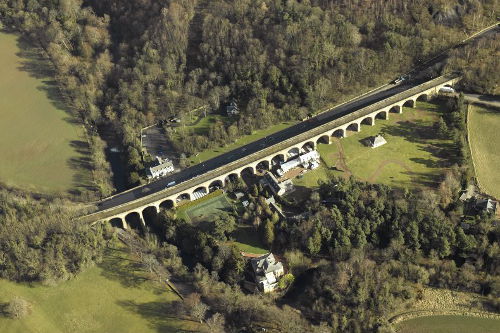Thursday September 6th 2018

A viaduct so well built that it survived 40 years of disuse before being pressed back into service on the new Borders Railway line has had a plaque unveiled as the railway celebrates its third anniversary.
The event forms part of the Institution of Civil Engineers (ICE) bicentenary celebrations, in which The Borders Railway is named in their top 200 People and Projects which have transformed people’s lives.
The masonry 23-arch Newbattle Viaduct across the River Esk near Dalkeith opened in 1849 to carry what became the Waverley Line but remained closed after the last freight train in 1972. It was found to be in such good condition that it served as a haul road for lorries removing spoil during construction of the Hardengreen Viaduct across the Dalkeith Western Bypass before regaining the rails that now carry a half-hourly ScotRail train between Edinburgh and Tweedbank.
Unveiling a plaque on the Sun Inn, dedicated to the historic civil engineering landmark, ICE Past President Professor Gordon Masterton said:
“The Borders Railways is one of eleven Scottish locations in the 200 projects being showcased for ICE 200, and the reuse of the Newbattle Viaduct is a testament to quality of design and construction that symbolises the excellence of the United Kingdom’s civil engineering traditions begun two hundred years ago by founding President Thomas Telford”.
A testament to the skill, precision and ingenuity of Civil Engineers who built it, the Newbattle Viaduct, still does today what it was built for 169 years ago.
Featured in the logo of the Borders Railway, the Newbattle Viaduct is one of 32 structures from the Waverley Line that were reused by the new route. It has 23 nearly semicircular arches, with 14 spans of 39 feet (12 m), seven of 38 feet (12 m), one of 44 feet (13 m) and one of 43 feet 10 inches (13.36 m). The piers are 8 feet (2.4 m) thick at the foundations, tapering to 6 feet (1.8 m) at the springing of the arches. The arches are lined with three layers of bricks, reinforced with iron strapping. The long pier which sits in the river has a large cutwater. The last arch at the south end is a skew arch to accommodate the A7 public road, which runs parallel to the viaduct before cutting underneath it. The viaduct is nearly straight, but with a slight curve at the northern end where it crosses the river.
Independent research has shown that the Borders Railway which reopened on 6 September 2015 is a major factor in attracting residents, workers and tourists. Work to stimulate business growth in the area continues, with the Borders Railway Blueprint Group’s ‘More Connected’ campaign highlighting the many opportunities in the line’s catchment for new and expanding enterprises. The Sun Inn is one of a host of businesses in Midlothian and the Scottish Borders that report many customers now coming by train.
ICE is running a year of events and activities that show how civil engineering has for over 200 years transformed the way we live, as well as highlighting the exciting range of careers that civil engineering offers. For further information please see https://www.ice.org.uk/ice-200
Tweet Share on Facebook